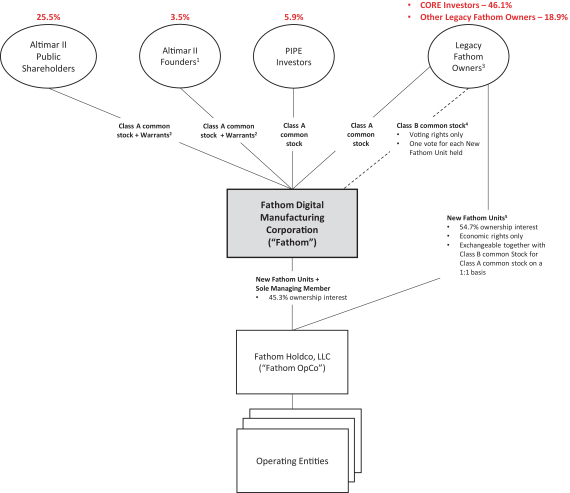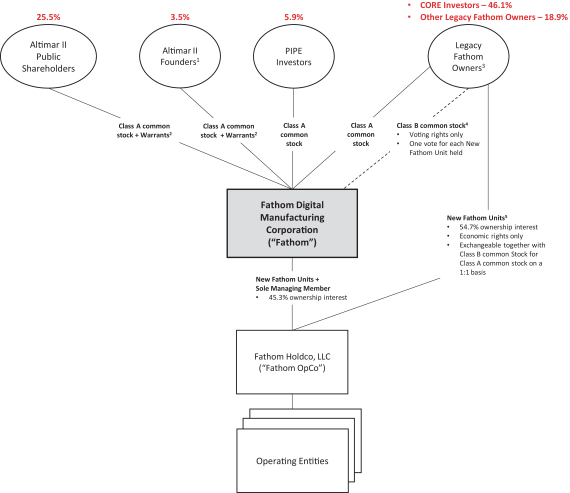“
Lien
” means, with respect to any specified asset, any mortgage, deed of trust, pledge, hypothecation, encumbrance, claim, easement, lease, sublease, covenant, license, option, right of priority, right of first offer or refusal, preemptive right, security interest or other restriction on transfer or lien of any kind.
“
Material Adverse Effect
” means, with respect to Fathom, an event, change, circumstance, occurrence, fact, development or effect, individually or in the aggregate, that would reasonably be expected to (x) be materially adverse to the business, assets, properties, results of operations or condition (financial or otherwise) of Fathom and its Subsidiaries, taken as a whole, or (y) the ability of Fathom to perform its obligations hereunder and to consummate the Transactions;
provided
,
however
, that in no event shall any of the following (or the effect of any of the following), alone or in combination, be deemed to constitute, or be taken into account in determining whether there has been or will be, a “Material Adverse Effect” on the results of operations or condition (financial or otherwise) of Fathom and its Subsidiaries, taken as a whole: (a) any change in applicable Laws or GAAP or any interpretation thereof after the date hereof, (b) any change in interest rates or economic, political, business, financial, commodity, currency or market conditions generally, (c) the announcement or the execution of this Agreement, the pendency or consummation of the Mergers or the performance of this Agreement (
provided
that the exceptions in this clause (c) shall not be deemed to apply to references to “Material Adverse Effect” in the representations and warranties set forth in
Section
5.04
and, to the extent related thereto, the condition in
Section
11.02(a)
), (d) any change generally affecting any of the industries or markets in which Fathom or its Subsidiaries operate or the economy as a whole, (e) any earthquake, hurricane, tsunami, tornado, flood, mudslide, wild fire or other natural disaster, act of God or other force majeure event, (f) any national or international political or social conditions in countries in which, or in the proximate geographic region of which, Fathom operates, including the engagement by the United States or such other countries in hostilities or the escalation thereof, whether or not pursuant to the declaration of a national emergency or war, or the occurrence or the escalation of any military or terrorist attack upon any Person or country, or any territories, possessions, or diplomatic or consular offices of the United States or such other countries or upon any United States or such other country military installation, equipment or personnel, (g) any failure of Fathom and its Subsidiaries, taken as a whole, to meet any projections, forecasts or budgets;
provided
, that clause (g) shall not prevent or otherwise affect a determination that any change or effect underlying such failure to meet projections or forecasts has resulted in, or contributed to, or would reasonably be expected to result in or contribute to, a Material Adverse Effect (to the extent such change or effect is not otherwise excluded from this definition of Material Adverse Effect) and
(h) COVID-19
or any Law, directive, pronouncement or guideline issued by a Governmental Authority that relate to, or arise out of, an epidemic, pandemic or disease outbreak (including the
COVID-19
pandemic), or any change in such Law, directive, pronouncement or guideline or interpretation thereof, in each case to the extent that they have the force of law or are binding on or affecting the Person to which they purport to apply, following the Execution Date or Fathom or any of its Subsidiaries’ compliance therewith;
provided
that in the case of clauses (a), (b), (d), (e), (f) and (h) such events, changes, circumstances, occurrences, facts, developments or effects may be taken into account to the extent (but only to the extent) that such changes have had a disproportionate impact on Fathom and its Subsidiaries, taken as a whole, as compared to other industry participants.


